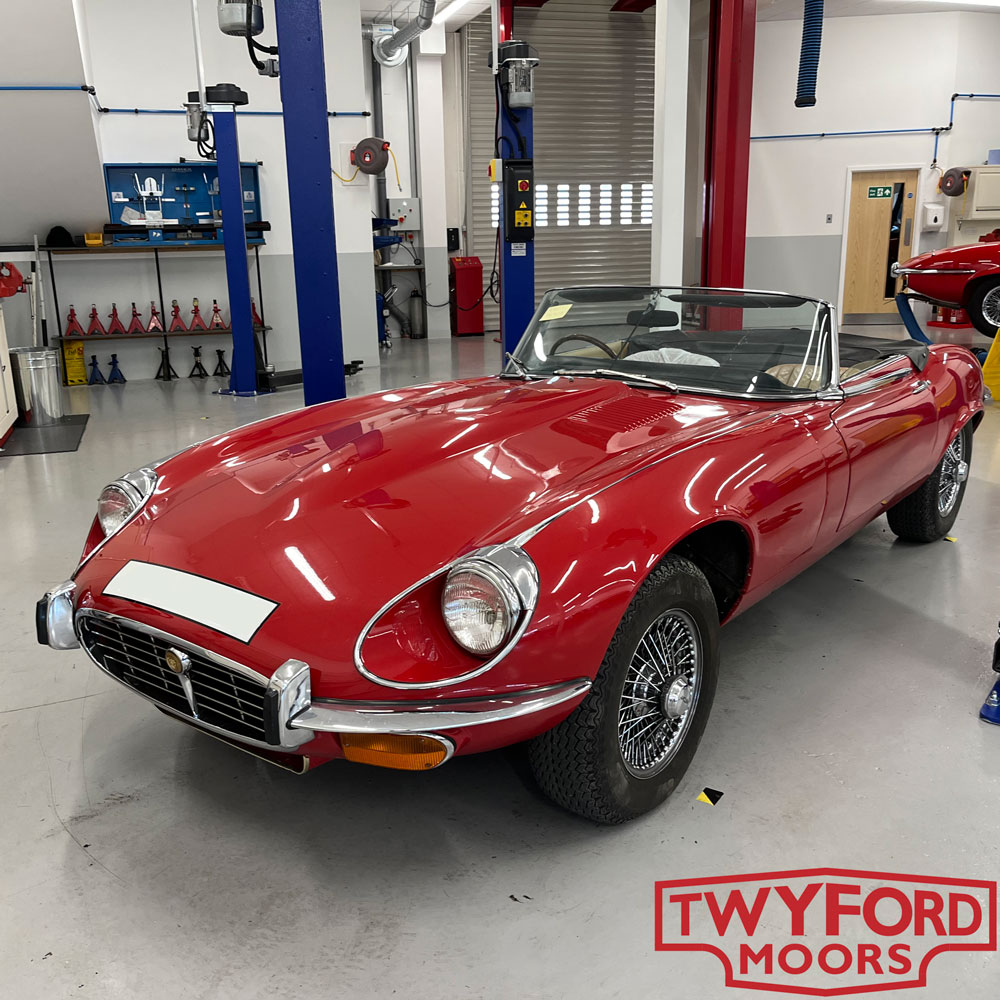Italian visitors and terrible tyres - Workshop update
A busy six weeks have passed since the last one of these workshop updates. In the intervening time, we have been extraordinarily busy in the workshop. We would like to thank all our customers, old and new, for entrusting us with their cherished classic cars. We have had a trip to Italy for the Mille Miglia, been at Goodwood for the Mike Hawthorn Memorial track day and had countless cars off on international tours. We also hosted our opening party and were delighted to welcome so many people into our new workshop. If you were not able to attend fear not as we hope to provide more open days, particularly for XK Club and E-Type Club members. To read about any of these please have a look at the news section of our website where you will find a series of articles.
In this week's update, we have a couple of Italian visitors, a lovely SS100 in for servicing, a truly shocking tyre and more XKs and E-Type than you can shake a stick at. Read on for a flavour of what we have been up to over the past few weeks.
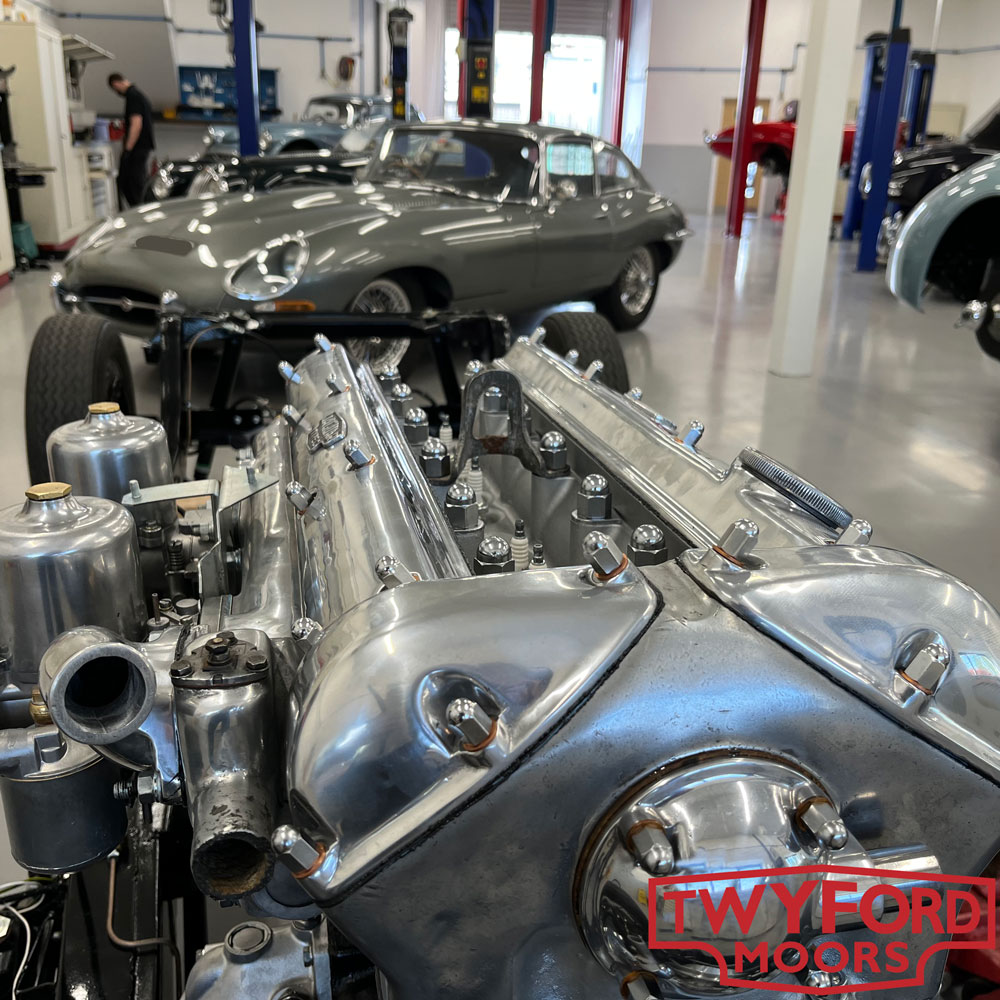
SS100
The SS100 is one of the rarest and most desirable pre-war Jaguars. ‘SS Cars’ was the name Jaguar traded by before World War 2. For obvious reasons, the SS brand seemed less desirable after the war. SS was a link back to William Lyons previous company Swallow Sidecar. Lyons along with his business partner William Walmsley had started off building motorbike sidecars and then moved into building two-seater sports cars based on chassis and engines supplied by the Standard Motor Company.
The SS100 is probably the most famous of the cars produced by SS and was in production from 1936 to 1939 with World War 2 putting a stop to production. The chassis was essentially a slight update to that of the earlier SS90 which in turn was a shortened version of the one designed for the 2 ½ litre saloon. The engine was based on a Standard 2 ½ litre pushrod engine with SS creating their own cylinder heads to convert it from a side valve arrangement to an overhead valve. In later years there was a 3 ½ litre version and plans for a fixed-head coupe, though only one was ever built.
This example is a 3 ½ litre which was in with us for a check-over and service. We are quite well versed in working on these SS cars now with quite a number visiting us regularly.
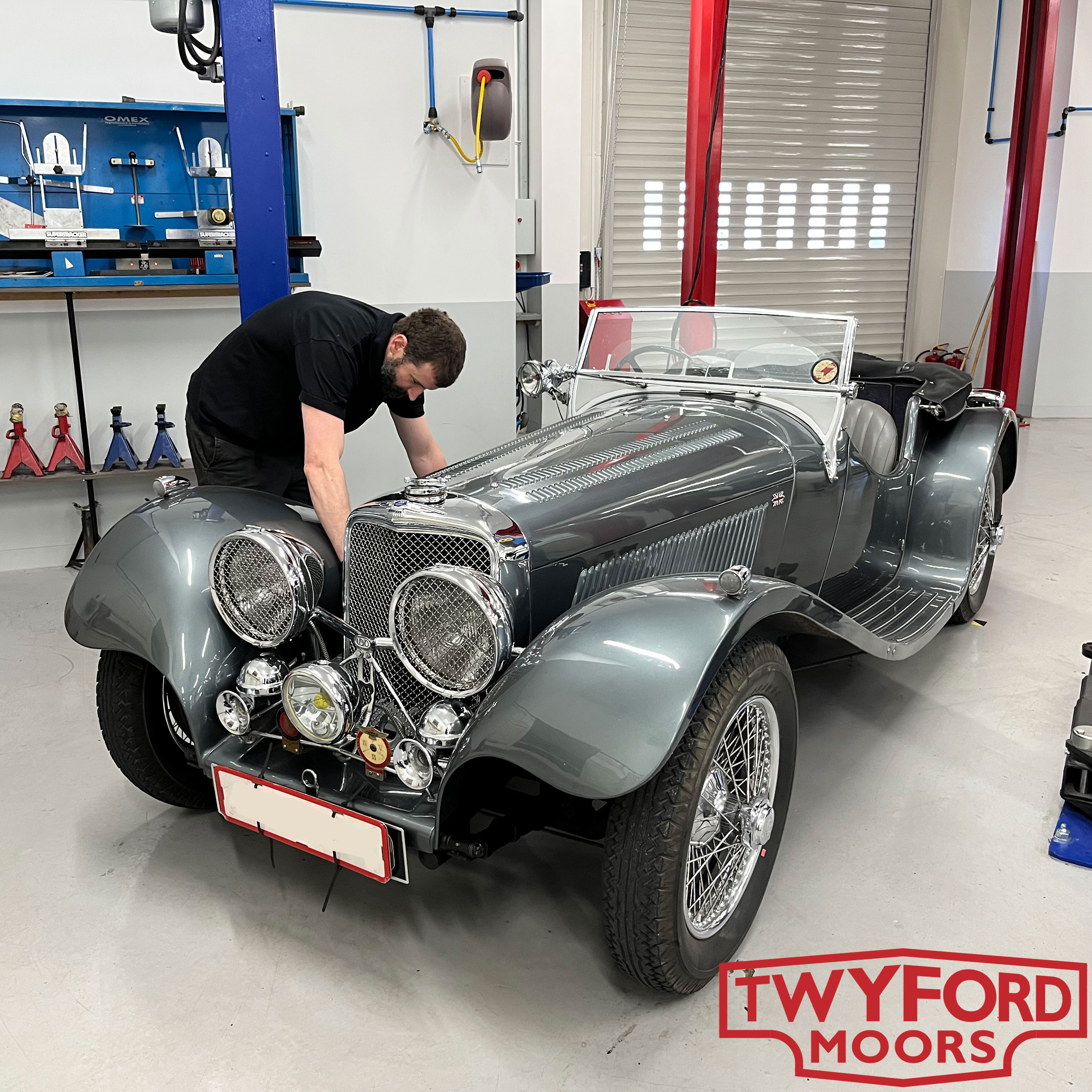
Jaguar XK120 restoration
Pictured here is a momentous step forward in the restoration of this Jaguar XK120 OTS. This car is undergoing full nut and bolt restoration. When we restore a car everything is stripped right down to its component parts so naturally, the body is separated from the chassis so that both can be repaired and painted properly. We have shared images of this car in previous posts of both the chassis being built up and the bodyshell in bare metal. Before the body is painted it is first fitted to the chassis and set up to ensure we achieve a top-quality fit. At this point, we also fit everything from headlights to hood frame to ensure everything fits and works properly ahead of paint. The body is then removed to be painted. At every step of the process, we take the time to ensure our XKs are as good as they can possibly be.
With the body painted it should be a straightforward task to refit it to the chassis as we have checked it before. This minimises the risk of any scratches or bumps to the fresh paintwork. Whenever possible we like to also have the engine and gearbox fitted to the chassis before the body goes on. This again minimises the risk of any damage as it is a tight squeeze fitting and engine into an XK120.

Fiat 124 power steering
As ever there are always a few non-Jaguar classics in our workshop. One such example is this lovely little Fiat 124. This is in fact one of two red Fiat 124s we have in. This car was in to have electric power steering fitted.
We were one of the earliest adopters of the EZ electric power-steering system and worked closely with them to develop the system for Jaguar XKs. We are so well-versed in fitting these systems that we do not just fit them to XKs and E-Types but will fit them to any classic car for which EZ produce a system for. Over the years we have fitted power steering to everything from an Aston Martin DB4 to an Austin 8.
The exact ins and outs of how the system fits varies from car to car. Some are easier than others but the overall system remains the same. The motor is generally hidden in the bulkhead area and leaves the car looking standard and the original steering box or steering rack untouched. This leaves the car driving as originally intended just with lighter steering. We even fit an on/off switch so that the assistance can be used as much or as little as the driver desires.
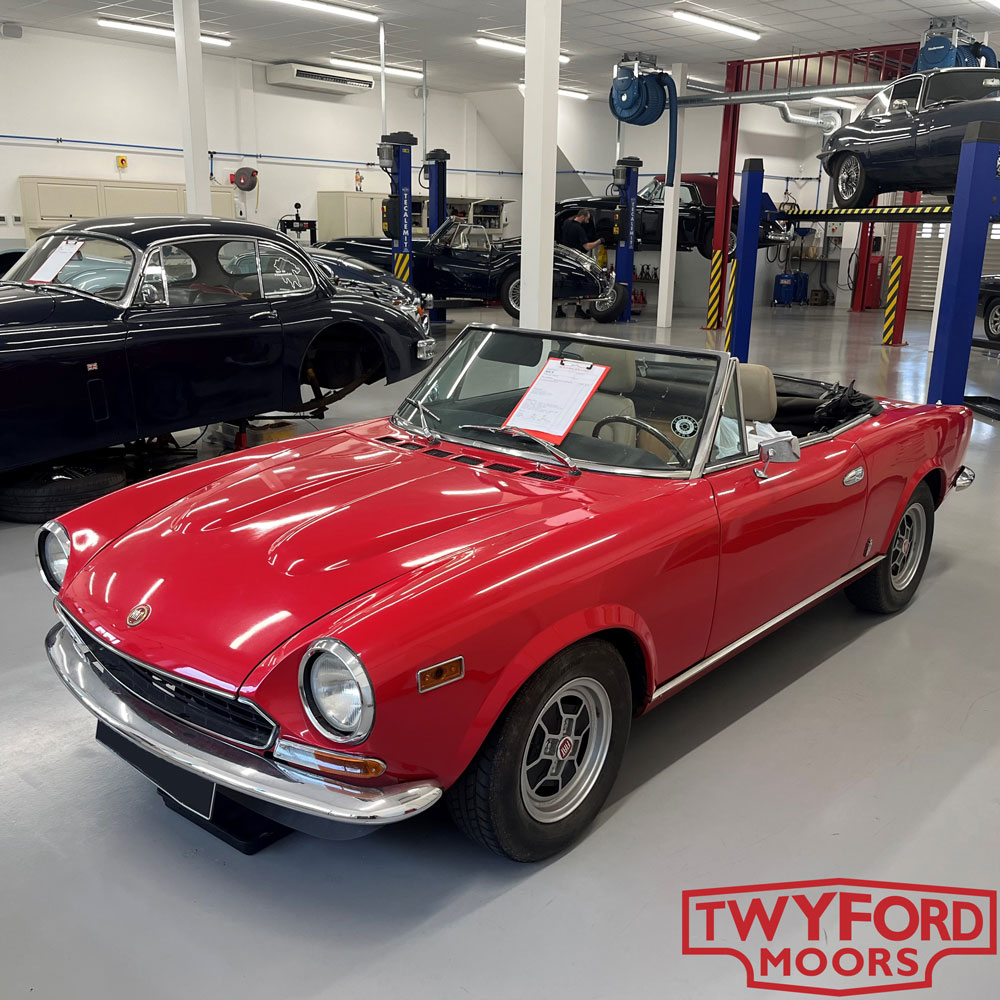
Jaguar XK120 OTS
This Jaguar XK120 OTS or roadster was in with us for some cosmetic work along with some minor faults to investigate. The overriders had been removed at some point in the past and stickers had been fitted giving the car something of a motorsport look. The owner wanted it to look more standard so we refitted the bumper irons and overriders as well as removing all the stickers.
The car is being used for touring and has a Brantz rally meter fitted which had stopped working. With a little investigation, it was found that due to the routing of the wiring, there was a poor connection at the speed sensor. With a little repair and some fiddly rerouting of the wiring, everything was working as it should again. We are lucky to have access to a very handy measured mile at the bottom of the road here so a short journey up the road saw the unit calibrated and ready to go for the next event.
Finally, we fitted a discreet double USB charging point flush to the under-dash panel. We really do rely on our mobile phones for so much these days. I mean who carries a map or CDs anymore? Using your phone all day long does take its toll on the battery so having easy access to charging is vital. We can fit these to both positive and negative earth cars.
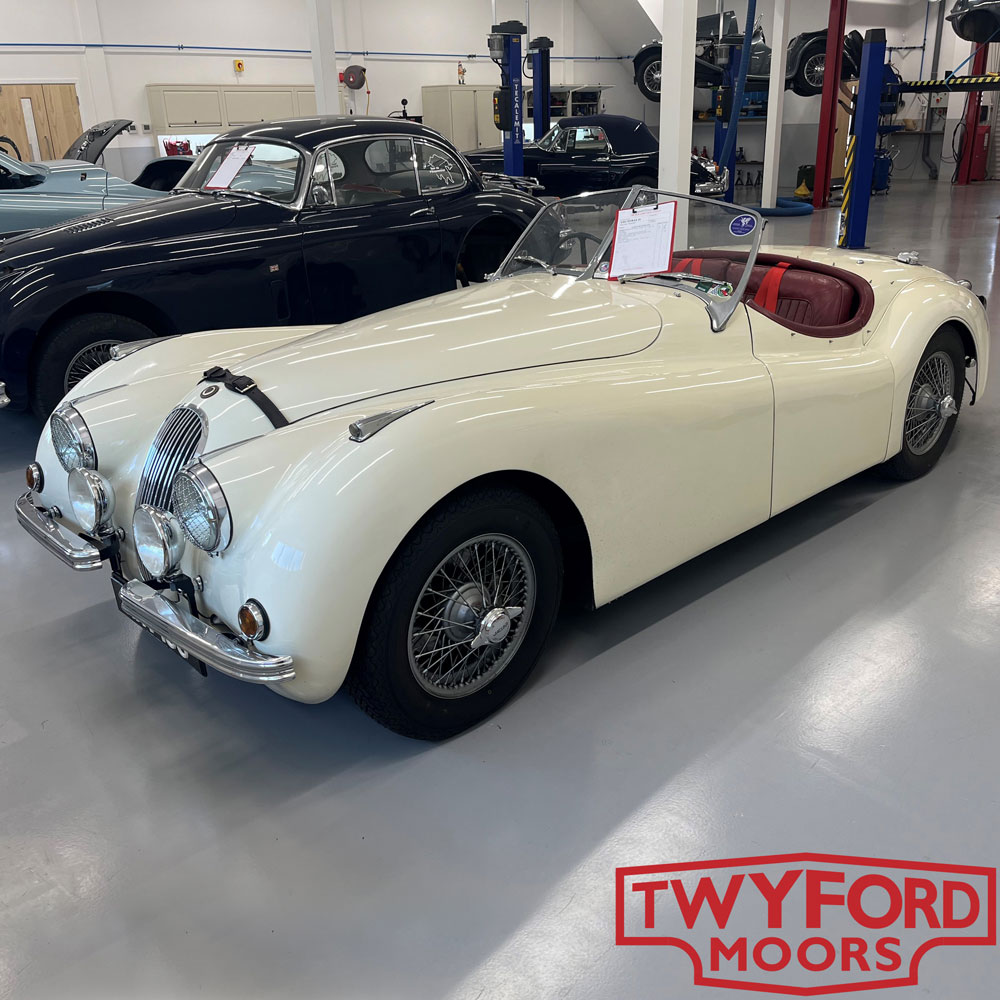
Jaguar E-Type from above
We wanted to share this image just because it is such a nice angel to view an E-Type from and is so rarely seen. We have not yet tired of the view from the safety rail at the top of the lift which takes cars from our workshop up to our first-floor storage facility. With cars heading up and down regularly, it is quite interesting to view them from a different angle.
I think most people would agree that the Jaguar E-Type is one of the most attractive cars ever designed. We would gently suggest that the coupe shape is nicer than the roadster. It is hard to beat this very early 3.8-litre FHC coupe. The enclosed headlights are a clear indication that it is a series 1 and you can just glimpse the aluminium centre console though which is a sure indicator of an early E-Type.
Although we are best known for our XKs we have a great deal of experience working on E-Types. Indeed, they have much in common with XKs. Be it restoration work, upgrades, servicing, or sales we offer a full range of services to E-Type owners. If you have an E-Type in need of attention please do get in touch.
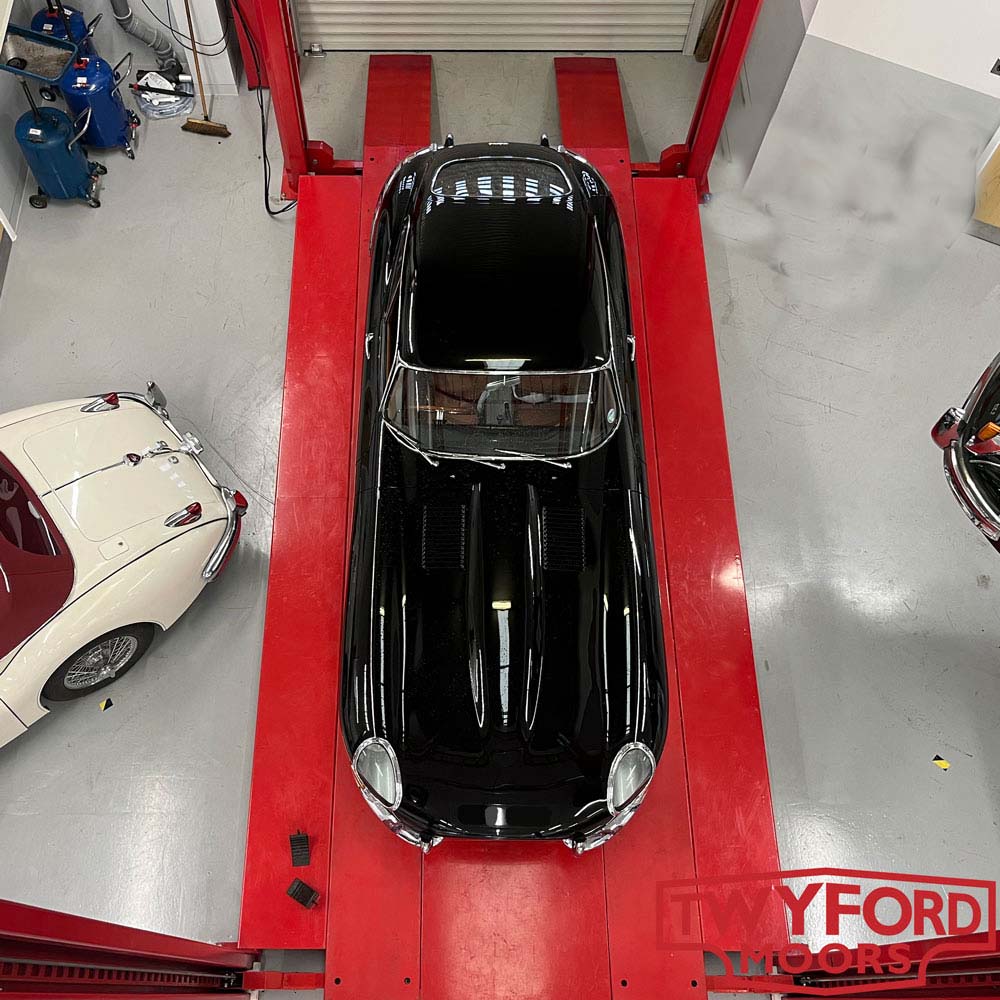
Iso Rivolta
Another Italian visitor is this rather unusual Iso Rivolta. Iso are possibly best known for its motorcycles and micro cars, particularly the Isetta bubble car. In the early 1960s, they decided to enter the luxury car market aiming to pitch themselves somewhere between Jaguar and Ferrari. The chassis was designed by Giotto Bizzarrini and the body was styled by Bertone. The goal was to generate a “Gran Turismo” car which could be used and enjoyed regularly whilst providing high performance and comfort.
The engine is a Chevrolet 327 V8 giving the car plenty of grunt. Four-wheel disc brakes were fitted as standard to provide adequate stopping power. The rear suspension uses a De Dion axle housing a Salisbury limited slip differential very similar to the arrangement fitted to the E-Type.
This example has been built as a track car and has come to use to be prepared and further developed to be used for historic rallying and touring. After much work, the car has had its first test day at Goodwood and seemed to provide plenty of smiles per mile for the new owner. We now have a list of tweaks and improvements to make over the coming months.
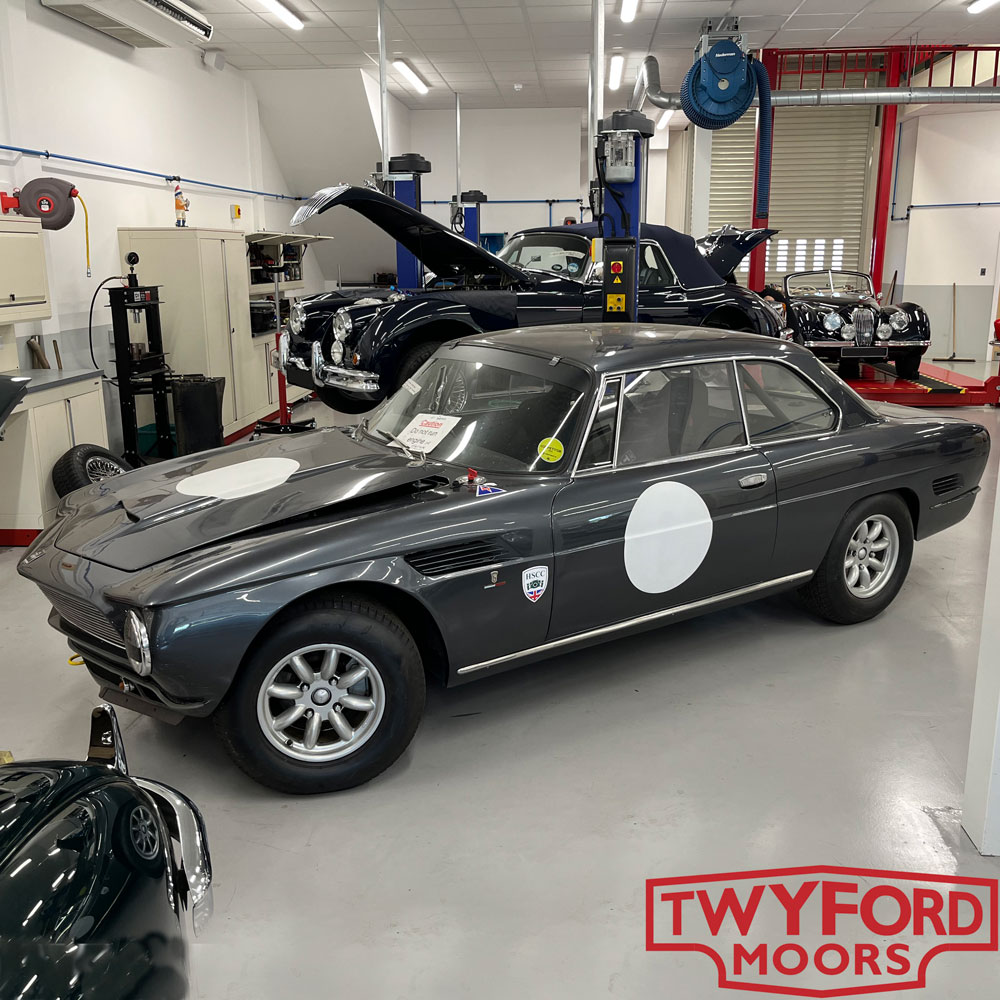
Always check your tyres
We often find that tyres are overlooked on classic cars. The most common issue is old tyres which still have plenty of tread left but are perished, have gone hard and are generally unsafe. Because classic cars often do few miles the tyres never get worn down to the point of low tread so just get old. It is well worth taking the time to check the date stamps on your tyres and think about replacing them if they are old. If you cannot find a date stamp on your tyres it likely means that they were made before the year 2000 and need replacing. The life span of tyres from different manufacturers varies from 6-10 years so if they are 6 years or older it is worth considering replacing them. Also, check for cracked or perished side walls.
Clearly, we all know to check our tread depth but as the picture demonstrates you cannot take it for granted that the tyres are wearing evenly. Always check across the full area of the tread and be particularly aware when checking front tyres. Pictured here is a particularly extreme example we recently had in the workshop. This had been caused by a misaligned front suspension. It just goes to show it is always worth thoroughly checking your tyres.
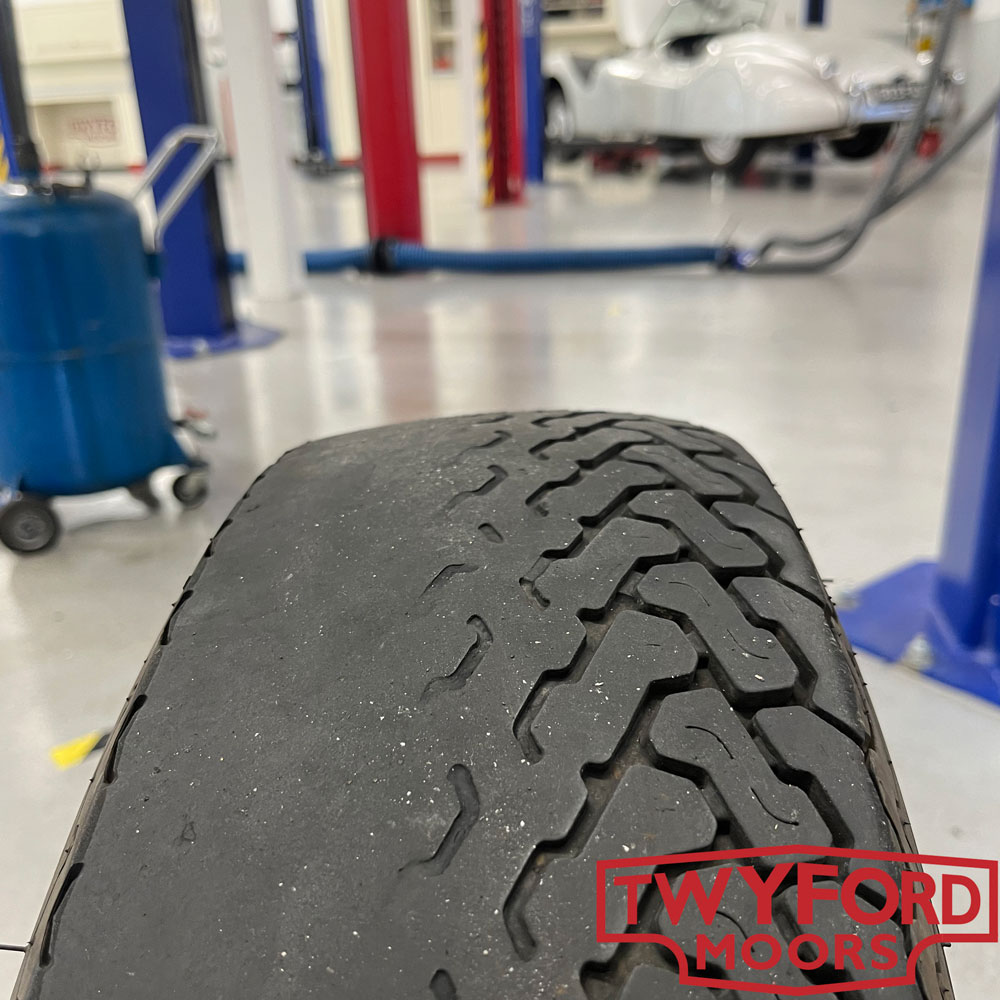
Jaguar E-Type rear axle
The rear suspension on the Jaguar E-Type is one of the elements that set it apart from its predecessors and contributed significantly to the way these cars drive. The system was so good that it went on to be fitted to all sorts of Jaguars including the S-Type, MK10 and XJs in varying forms. The system provides independent suspension with the differential and brakes mounted inboard in a subframe. This gives a significant reduction in un-sprung weight.
It does however offer several complications when it comes to servicing and maintenance. Access to the brakes to change pads is challenging, particularly on the series 3. To change any significant components such as the brake disc one really needs to remove the subframe assembly. Fortunately, we are quite well-practised at getting these in and out.
Often overlooked are the subframe and trailing arm bushes. If these are in poor condition, they significantly compromise the handling of the car. Do be sure to check yours.
The rear axle from this E-Type has been removed to have new discs fitted along with upgraded aluminium brake callipers and an improved handbrake mechanism. Those who have lived with an E-Type will know how poor the original handbrake can be. Whilst it’s out we will also give the whole assembly a good clean-up and paint.
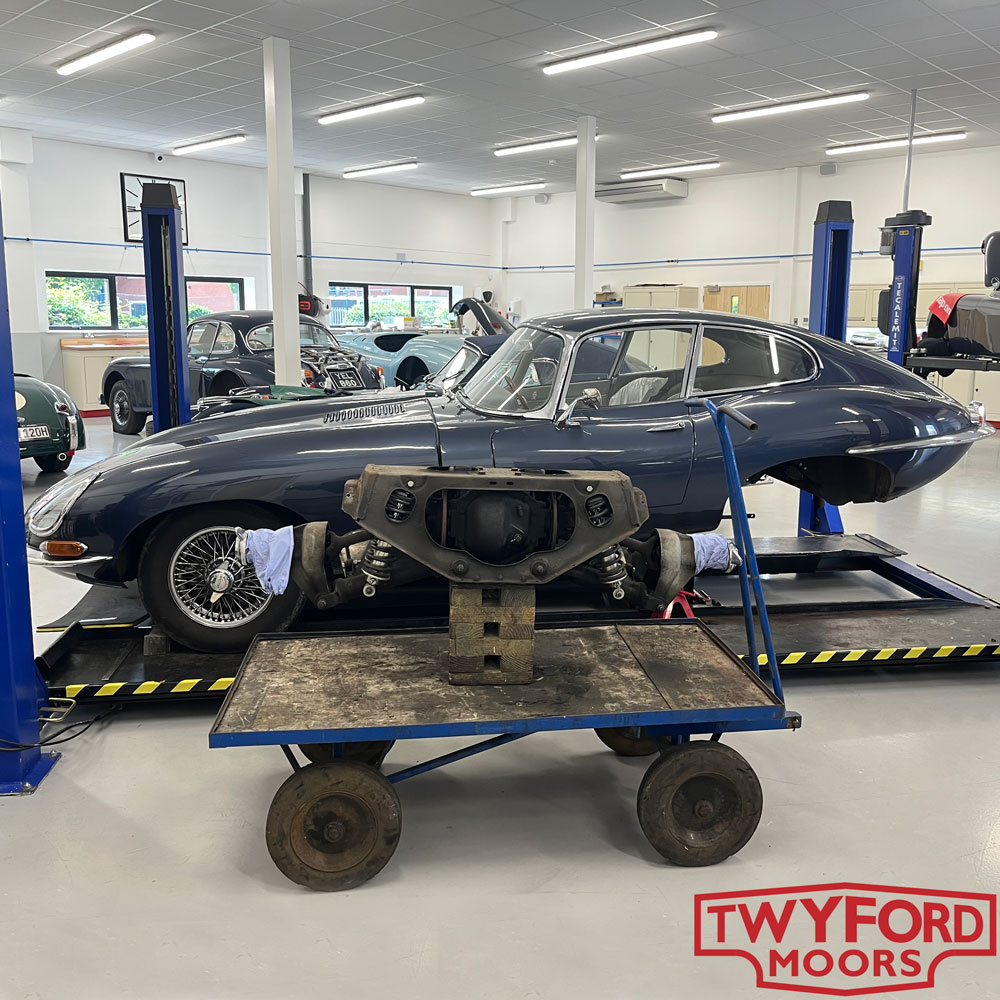
Jaguar XK120 FHC
The XK120 FHC has to be one of the most attractive cars of all time. This example underwent a full nut and bolt restoration here at Twyford Moors over a decade ago. At this time, it was extensively upgraded to improve the driving experience. Despite the relatively subtle styling changes the XK range leapt forward in terms of the technology that went into them between the XK120, XK140 and XK150. One of the biggest steps forward was changing from a steering box on the XK120 to rack and pinion steering on the XK140 and XK150.
This XK120 FHC has been fitted with our rack and pinion steering upgrade bringing it up to the same standards as the XK140 and XK150. A tell-tale sign that it has this upgrade is that the original upright XK120 radiator has been replaced with one of our sloping aluminium radiators to allow it to clear the steering rack.
Another issue people often come across with the XK120 is that the cabin space is quite limited. The XK140 offers significantly more leg room and the XK140 FHC has a very spacious cabin. We offer several upgrades that allow taller drivers to drive an XK120 in comfort. The easiest of these upgrades is fitting bucket seats and a smaller steering wheel. We also can move the bulkhead further into the engine bay and fit a pedal box to give more legroom. If that does not create enough room we can also alter or remove the battery boxes, which are located behind the seats, to allow the seats to go back further.
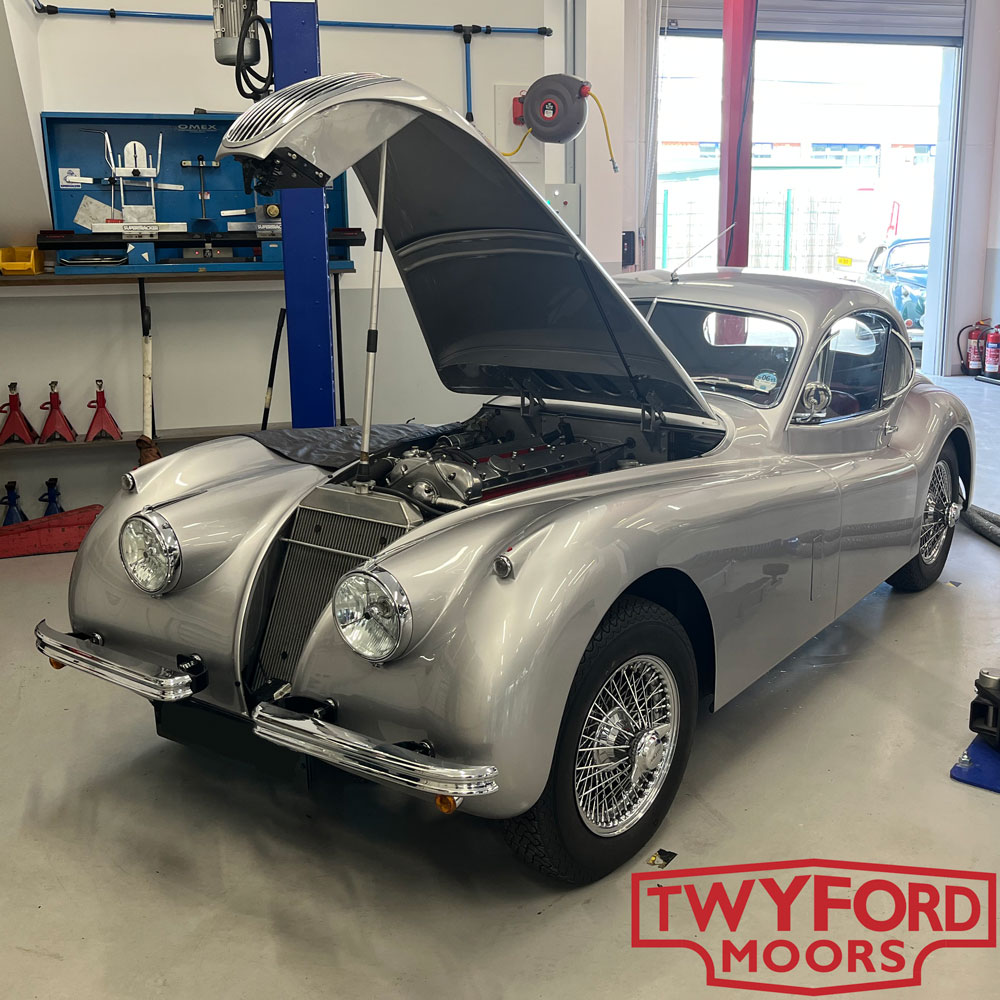
Jaguar E-type Series 3
We are seeing a lot of these lovely V12 E-Types at the moment. At one point a couple of weeks ago we had three red series 3 E-Types in at once. In the background of this photo, you can just see the rear end of another V12 which was having a five-speed gearbox fitted.
These lovely E-Types do seem to be growing significantly in popularity and they have a lot to recommend them. For a start they offer so much more room and comfort so if you are a taller driver, they are well worth considering. Also, if your knees, hips, back or any other part of your anatomy make getting in and out of an early E-Type challenging it might well be worth trying a series 3. The wider cabin and longer doors really do make a significant difference.
This example was in with us for its annual service. There was nothing significant to report or requiring attention so it was very quickly ready for another year of enjoyment.
